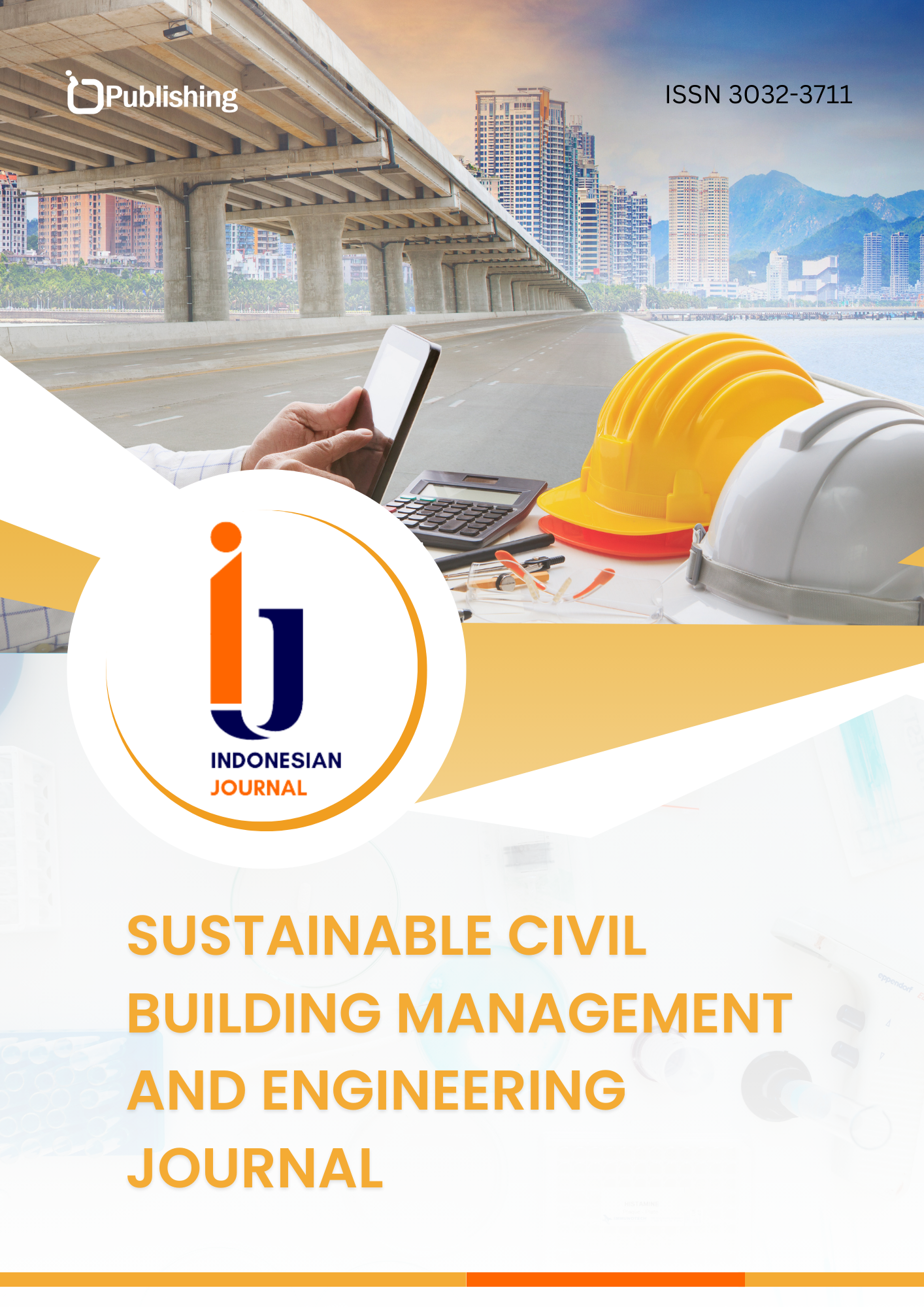Identifikasi Waste menggunakan Metode Borda dan Penerepan Lean Construction Tools dengan Root Cause Analysis (Studi Kasus: Proyek Pembangungan Gelanggang Inovasi dan Kreatif Universitas Gadjah Mada)
DOI:
https://doi.org/10.47134/scbmej.v1i2.3001Keywords:
Lean Construction, Waste, Borda, RCAAbstract
Dalam pembangunan bangunan sipil sering terjadi masalah, terutama karena adanya pemborosan dalam bentuk non-value added activity. Pemborosan ini dapat dipengaruhi oleh faktor-faktor seperti man, money, material, machine, method, dan minute. Untuk mengatasi masalah ini, diperlukan inovasi seperti penerapan manajemen Lean Construction yang bertujuan untuk menginvestigasi dan mengurangi pemborosan. Salah satu metode untuk mengidentifikasi pemborosan adalah dengan menggunakan Root Cause Analysis (RCA). Dalam penelitian kali ini akan berfokus untuk mengidentifikasi variabel serta faktor apa saja yang menjadi penyebab terjadinya waste berupa non-value added activity yang paling berpengaruh apabila terjadi pada Proyek Gelanggang Inovasi dan Kreatif UGM. Penelitian ini memiliki tujuan untuk melakukan identifikasi, analisis, dan memberikan rekomendasi dari waste yang terjadi dengan menggunakan pendekatan terhadap konsep Lean Construction. Penelitian ini menggunakan data berupa kuesioner yang diisi oleh pekerja terkait dan diolah dengan menggunakan metode borda. Dari analisis menggunakan metode tersebut akan didapatkan pembobotan dari masing-masing variabel serta faktor yang ada, selanjutnya hasil dari analisis tersebut akan digambarkan dalam bentuk grafik (pie chart) untuk mengetahui pemeringkatannya. Dari penelitian yang dilakukan mendapatkan hasil berupa variabel serta faktor yang paling berpengaruh yaitu Variabel Waste of Money (bobot 0,2009 atau 20,09%) dengan faktor yang paling mempengaruhinya yaitu “Terjadi Kesalahan Saat Perhitungan RAB” (bobot 0,2716 atau 27,16%).
References
Alarcón, L.F. (1997). Tools for The Identification and Reduction of Waste In Construction Projects.
Al-Moghany, S. S. (2006). Managing and Minimizing Construction Waste In Gaza Strip. Managing and Minimizing Construction Waste in Gaza Strip.
Aravindh, M. D. (2024). Identification of the Lean Tools Used in the Tamil Nadu Construction Industry. Lecture Notes in Civil Engineering, 398, 583–594. https://doi.org/10.1007/978-981-99-6229-7_52 DOI: https://doi.org/10.1007/978-981-99-6229-7_52
Ashish, A. (2024). Exploring Defects in Construction—An Experimental Study. Lecture Notes in Civil Engineering, 383, 389–399. https://doi.org/10.1007/978-981-99-5455-1_33 DOI: https://doi.org/10.1007/978-981-99-5455-1_33
Bhaskara, A., Ginting, A. A., & Masagala, A. M. (2022). Penerapan Konstruksi Ramping terhadap Waste pada Ruang Lingkup Manajemen Proyek (Studi Kasus: Proyek Pembangunan Gedung Auditorium di Yogyakarta). Semesta Teknika, 25(1), 80–88. DOI: https://doi.org/10.18196/st.v25i1.13403
Chasan Mudzakir, A., Setiawan, A., Agung Wibowo, M., & Radian Khasani, R. (2017). Evaluasi Waste dan Implementasi Lean Construction (Studi Kasus: Proyek Pembangunan Gedung Serbaguna Taruna Politeknik Ilmu Pelayaran Semarang). Jurnal Karya Teknik Sipil, 6(2), 145–158.
Erazo-Rondinel, A. A. (2021). Diagnosis and improvement of the level of implementation of the Last Planner® System in a Construction project. 2021 7th Congreso Internacional de Innovacion y Tendencias En Ingenieria, CONIITI 2021 - Conference Proceedings. https://doi.org/10.1109/CONIITI53815.2021.9619594 DOI: https://doi.org/10.1109/CONIITI53815.2021.9619594
Gartoumi, K. I. (2024). Implementing lean construction to improve quality and megaproject construction: a case study. Journal of Financial Management of Property and Construction, 29(1), 1–22. https://doi.org/10.1108/JFMPC-12-2022-0063 DOI: https://doi.org/10.1108/JFMPC-12-2022-0063
Heet, M. R. A. H. Al. (2020). Investigation of the use of lean construction practices in transportation construction projects. IGLC 28 - 28th Annual Conference of the International Group for Lean Construction 2020, 541–552. https://doi.org/10.24928/2020/0121 DOI: https://doi.org/10.24928/2020/0121
Ibrahim, M. W. (2017). Implementation of lean thinking in planning piping hydro-testing activities. SPE Middle East Oil and Gas Show and Conference, MEOS, Proceedings, 2017, 1159–1165. https://doi.org/10.2118/183736-ms DOI: https://doi.org/10.2118/183736-MS
Ibrahim, M. W. A. (2022). Low Capital Investment Approach to Foster Organizational Change Towards a Continuous Improvement Culture. Society of Petroleum Engineers - ADIPEC 2022. https://doi.org/10.2118/210825-MS DOI: https://doi.org/10.2118/210825-MS
Kamaruzzaman, F. (2012). Studi Keterlambatan Penyelesaian Proyek Konstruksi (Study of Delay In The Completion of Construction Projects). Jurnal Teknik Sipil Untan, 12(2), 175–190. DOI: https://doi.org/10.26418/jtsft.v12i2.1435
Kementerian PUPR. (2019). Profil dan Pola Penanganan Risiko Penggantian dan/atau Duplikasi Jembatan Callender Hamilton (CH) di Lintas Utama Pulau Jawa.
Larkin, K., Odeyinka, H., & Eadie, R. (2012). An Exploration of Theoretical Concepts and Methods for Assessing Risk Impacts on the Variability between Contract Sum and Final Account in Design and Build Projects. Association of Researchers in Construction Management, 1, 337–346.
Nguyen, T. (2018). A relook at plan reliability measurements in lean construction and new metrics from digitized practical implementation. IGLC 2018 - Proceedings of the 26th Annual Conference of the International Group for Lean Construction: Evolving Lean Construction Towards Mature Production Management Across Cultures and Frontiers, 2, 1037–1046. https://doi.org/10.24928/2018/0216 DOI: https://doi.org/10.24928/2018/0216
Pradeep, M. S. (2024). Identification and Reduction of the Manpower Waste in Construction Using Work-Sampling Analysis. Lecture Notes in Civil Engineering, 383, 127–136. https://doi.org/10.1007/978-981-99-5455-1_10 DOI: https://doi.org/10.1007/978-981-99-5455-1_10
Presdir Bukaka Teknik Utama Tbk, & Pemrakarsa Proyek KPBU Jembatan Di Jawa. (2023). Rekonstruksi Jembatan CH, Tingkatkan Konektivitas Antar Wilayah. In Putrawan & R. E. Aprilia (Eds.), Media Informasi Direktorat Jenderal Pembiayaan Infrastruktur Pekerjaan Umum dan Perumahan (1st ed., Vol. 4, pp. 1–25). Kementerian Pekerjaan Umum dan Perumahan Rakyat.
Ramani, V. (2024). Improving Handing Over of Residential Units Using Lean Tools. Lecture Notes in Civil Engineering, 383, 285–290. https://doi.org/10.1007/978-981-99-5455-1_23 DOI: https://doi.org/10.1007/978-981-99-5455-1_23
Rani, H. A. (2016). Manajemen Proyek Konstruksi. Deepublish.
Saxena, A. K. (2024). Cycle-Time Improvement Through Collaborative Planning System. Lecture Notes in Civil Engineering, 383, 343–350. https://doi.org/10.1007/978-981-99-5455-1_29 DOI: https://doi.org/10.1007/978-981-99-5455-1_29
Seleem, S. N. (2020). A lean manufacturing road map using fuzzy-DEMATEL with case-based analysis. International Journal of Lean Six Sigma, 11(5), 917–942. https://doi.org/10.1108/IJLSS-12-2017-0147 DOI: https://doi.org/10.1108/IJLSS-12-2017-0147
Russell, N. (2007). Complexity of control of Borda count elections [A Thesis Submitted in partial fulfillment of the requirements for the degree of Master of Science in Computer Science, Rochester Institute of Technology].
Tamallo, M. G., & Nursin, A. (2020). Evaluasi Non-Physical Waste dengan Lean Construction pada Proyek Gedung Sanggala. PROKONS: Jurnal Teknik Sipil, 14(2), 12–18. DOI: https://doi.org/10.33795/prokons.v14i2.294
Torres Formoso, C., Luís Isatto, E., & Hirota, E. H. (1999). Method for Waste Control In The Building Industry. In Proceedings IGLC (Vol. 7, p. 325), 325–334.
Wardhana, A., Santoso, R., Sofianiyatin, L., Maulidizen, A., Apriyanti, Sari, F. P., Sihab, M., Rosiana, M., Kosasih, Mahanani, E., Dyanasari, Abdurohim, Mulyadi, Y. E., Aziz, A. A., & Kusnadi, I. H. (2022). Konsep dan Implementasi Manajemen Strategi (Suwandi, Ed.). Eureka Media Aksara.
Womack, J. P. & Jones, D. T. (2010). Lean Thinking: Banish Waste and Create Wealth In Your Corporation. Simon and Schuster.
Downloads
Published
How to Cite
Issue
Section
License
Copyright (c) 2024 Ardymas Febrian Saputra, Muji Rifai, Fajar Sri Handayani

This work is licensed under a Creative Commons Attribution 4.0 International License.










